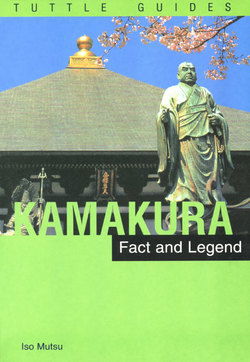Читать книгу Kamakura: Fact & Legend - Iso Mutsu - Страница 10
На сайте Литреса книга снята с продажи.
ОглавлениеPreface
ISO MUTSU, an Englishwoman long married to a Japanese diplomat and philanthropist, lay dying. My father sat at her bedside in our home in Kamakura. Her last words softly spoken to him were: "How beautiful! The sunset." Soon afterward she lapsed into final sleep.
My father observed that from her reclining position in bed, with her back to the wall and facing an eastern window, it had been impossible for her to admire the sunset—as she had been wont to do—except in her own mind's eye.
At the time I was in England. Years later, in Japan, I heard my father recount the episode. He thought the last self-created vision most fitting for one who all her life had been deeply devoted to the beauties of Kamakura. One of the sights she loved most was that of the sun setting beyond the bay, in a symphony of changing colors, into the low, pale-blue ridges of the Izu mountains outlined far away in the West.
Kamakura: Fact and Legend is a product of the attachment this Englishwoman, an intense lover of poetry, painting, and music, had for an old Japanese seaside town, where she preferred to live more than in any other place.
During my boyhood days spent in Kamakura, I was frequently a rather bored companion of my mother on her numerous trips to the city's temples and shrines. She would visit them over and over again for the gentle pleasure they gave her and to gather material for her forthcoming book. I was then far too young to share in the quiet enjoyment. Yet I can remember vividly several minor incidents: my mother stopping for several minutes on a winding path, halted by the music of the wind in a thicket of bamboo trees; her pauses on the stone steps of a temple to listen to a group of Buddhist priests chanting a sutra to the accompaniment of poundings on their drum. Often she would tell me stories about the strange legends and exciting events of the remote past attached to these places, and she presented them so well that I still remember them.
The remains of Iso Mutsu repose in our family grave at the temple of Jufuku-ji, which is one of the oldest in Kamakura. The same cavelike sepulcher contains the ashes of her husband, Hirokichi Mutsu, and those of her father-in-law, Count Munemitsu Mutsu, a distinguished Japanese statesman of the Restoration era. Not far away, also in a little cave, stands the ancient tomb of Masako Yoritomo, founder of Jufuku-ji temple. Masako was the consort of Minamoto no Yoritomo, the man who established and ruled Kamakura as the capital of feudal Japan about seven centuries ago.
The death of Iso Mutsu occurred in 1930, during the forenoon of May 12, another reason why she could not have actually seen the sunset. My father wrote in English in his diary: "A peaceful end came at last to the placid life of Iso, at 9:10 A.M., with no suffering in the presence of Death."
The Kamakura temples and environs have changed little to this day and shed the same tranquil charm for those who wish to go to the trouble of visiting them. Kamakura city itself escaped any direct attack in the last war, and subsequently its population has considerably grown. Due to the development of transportation, the city today is far more heavily thronged by sightseers and holiday-makers, particularly during the summer, compared to the times when this book was written. But fortunately most of the places mentioned in it, with the exception of one or two very famous temples, continue to remain off the regular path of the multitudes. Kamakura's physical features are about the same except for the construction of a highway along the northern edge of Yiiigahama Beach, the erection of a steel observation tower which rather mars the distant appearance of picturesque Enoshima island and the opening of a somewhat modernistic art gallery on the grounds of Tsurugaoka Hachiman Shrine. This establishment, along with the Tokyo National Museum, now houses many relics and treasures of art which footnote the history of Kamakura.
Considerable devastation was wrought by the great earthquake of 1923, and some of the geographical changes affect this book. For example, the "Hundred Kannon of Enkaku-ji" are no longer located in caves above the temple, but are now to be found on the temple's grounds. Where changes are considerable, this revised edition has footnoted them for the reader's benefit.
The thrilling history and romantic legends surrounding this ancient feudal capital come alive for the visitor to Kamukura who knows of them. I am pleased to see that yet another generation of readers will enjoy this wondrous experience.
—IAN MUTSU
Tokyo
